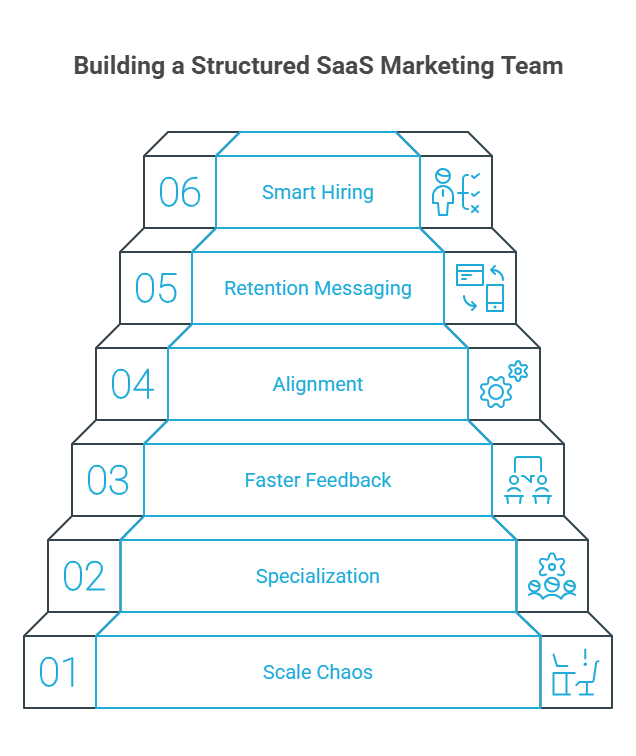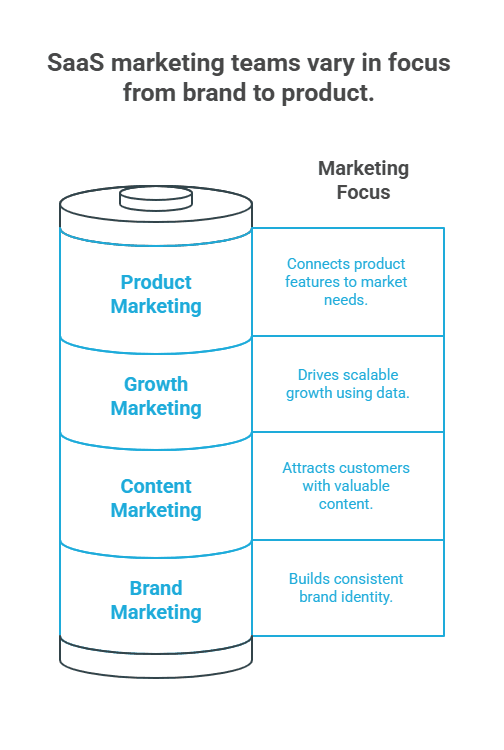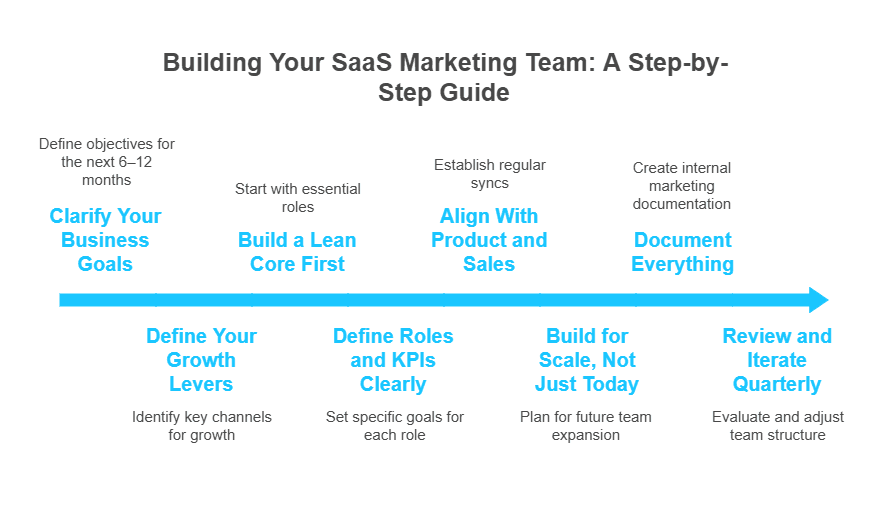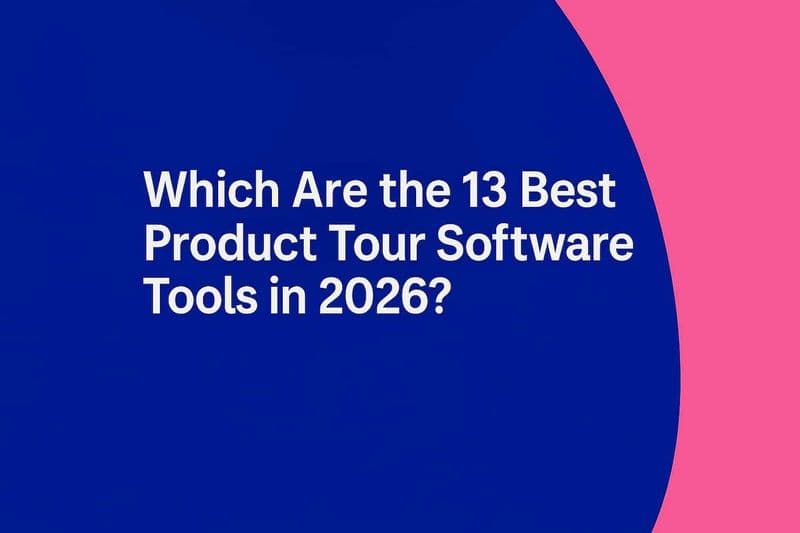
You're wearing too many hats, and marketing is slipping through the cracks. Sound familiar? As a SaaS founder, you’re juggling product, fundraising, and growth, but without a clear marketing team structure, your customer acquisition stalls, your messaging gets messy, and your competitors race ahead.
In a fast-moving, digital-first market, guesswork doesn’t cut it. You need a marketing team built for clarity, speed, and scale. This guide walks you through how to structure that team from the ground up—aligned with your business goals, flexible enough to grow with you, and focused on what actually drives results through various channels, including social media marketing.
Why Building a SaaS Marketing Team Structure Is Important?

If you're a SaaS founder, you already know that building a great SaaS product isn’t enough. Without a structured marketing team, you're gambling with growth. A clear marketing org isn’t just about delegation—it’s about scaling revenue, creating alignment, and moving faster with less friction.
Here’s why building a dedicated SaaS marketing team structure should be a top priority:
1. You Can’t Scale Chaos
Ad-hoc marketing might get you through the MVP stage, but it breaks down fast. A structured team brings clarity—who owns acquisition, who drives retention, and who’s tracking performance. Without this, you're flying blind as you scale.
2. Specialization Drives Results
In SaaS, the marketing department isn’t one job. It’s content strategy, SEO, paid growth, product marketing, lifecycle, leveraging various digital channels in digital marketing, and more. A structured team lets specialists own their lane, rather than one generalist trying to do everything halfway.
3. Faster Feedback Loops
With defined roles, your team can test campaigns, analyze results, and iterate quickly. Whether it’s A/B testing landing pages or refining email flows, speed wins in SaaS. Structure removes bottlenecks.
4. Alignment With Product and Sales
A good marketing team bridges product and revenue. Product marketers translate features into benefits. Growth marketers align with sales to generate qualified leads. Without structure, cross-functional alignment turns into guesswork.
5. Retention Starts With the Right Messaging
Most SaaS churn isn’t a product problem—it’s a positioning problem. A structured team ensures your messaging stays consistent from ad to onboarding to upsell, reducing churn and improving LTV.
6. You’ll Hire Smarter
When you know the structure you need, you can hire intentionally, not reactively. Whether you’re bringing on a head of growth, a content lead, or a lifecycle marketer, you’ll know exactly what impact they’re responsible for.
What Are the Key Roles in a Typical SaaS Marketing Team?

As a SaaS founder, once you commit to structuring your marketing function, the next step is identifying which roles matter most. You don’t need a massive team to see results, but you do need the right people in the right seats.
1. Product marketing team
The product marketing team connects your product with the market by understanding its features and competitors, then positioning it effectively to enhance customer retention. They translate technical details into clear benefits for your audience.
Product marketer: Crafts go-to-market plans and messaging that address customer needs.
Competitive intelligence analyst: Analyzes competitors and market trends to differentiate your product.
2. Growth marketing team
This team drives fast, scalable growth by acquiring users, optimizing conversions, and improving retention using data-driven strategies.
Key roles:
Growth marketer: Identifies growth channels, runs tests, and improves customer journeys.
CRO specialist: Enhances user experience to boost conversion rates.
Marketing analyst: Tracks key metrics to optimize campaigns and budget.
3. Content marketing team
Creates and shares valuable content to attract and convert customers, improve SEO, and build trust.
Key roles:
Content marketer: Produces content that drives traffic and guides prospects.
SEO specialist: Optimizes content and website for search visibility.
Social media manager: Builds brand presence and engages audiences.
Paid social expert: Manages paid social ads to generate leads.
Email marketing lead: Runs campaigns that nurture and convert leads.
4. Brand marketing team
Builds and maintains a strong, consistent brand identity that shapes customer perception and loyalty.
Key roles:
Brand marketer: Develops brand strategy and messaging.
PR specialist: Manages media relations and public image.
Graphic designer: Creates visual materials for consistent branding.
How to Prepare to Build a SaaS Marketing Team?

If you're a SaaS founder gearing up to build your first real marketing team, the stakes are high. Get it right, and you lay the foundation for predictable growth. Get it wrong, and you burn cash on scattered efforts with no real traction.
1. Define Your Stage and Priorities
Are you pre-product market fit, in growth mode, or scaling rapidly? Your stage defines your needs.
Early-stage: Focus on generalists who can do a bit of everything.
Growth stage: Start hiring specialists to own acquisition, content, product marketing, etc.
2. Map Marketing to Revenue Goals
Before hiring a director of marketing and a marketing operations manager, get clear on your revenue goals and how marketing contributes to your marketing activities and marketing goals. Are you trying to generate more signups, reduce churn, drive enterprise leads, or increase LTV? Define the key outcomes you want marketing to influence—this will help you shape your org chart intentionally.
3. Audit What’s Already Working
If you’ve already been running ads, publishing content, or sending email campaigns, take stock.
Where is traction happening? What’s underperforming?
Use data to identify what to double down on—and what gaps your first hires need to fill.
4. Outline the Roles You Actually Need
Don’t just copy another company’s team structure. Build around your business model, funnel, and growth strategy.
If most of your leads come from organic search, prioritize content and SEO.
If you rely on outbound or PLG, hire for growth and product marketing.
5. Build the Right Tech Stack Early
A lean, efficient stack makes your team faster from day one.
Make sure software tools for email, CRM, automation, analytics, and attribution are in place—or at least scoped—before scaling the team.
Don’t let your hires get bogged down in tech debt from day one.
6. Set Clear Metrics and Ownership
Every role you hire should have clear KPIs tied to business outcomes—traffic, signups, retention, pipeline contribution, etc.
Clarity on “who owns what” keeps performance measurable and helps new hires ramp quickly.
7. Decide What to In-House vs. Outsource
You don’t need to do everything internally right away.
Some functions—like SEO, paid media, or video—can be outsourced early, while you build in-house strength in core areas like growth or product marketing.
8. Document Your Brand and Voice
Even if it’s simple, create a basic brand guide: tone, visuals, message pillars, positioning.
This helps your new team members stay aligned and prevents inconsistent messaging as you grow.
Step-by-Step Guide to Structuring Your Marketing Team

As a founder, you can’t afford to “figure it out as you go” when it comes to marketing hires. Structure creates clarity, improves output, and makes your team accountable for growth, not just activity. Here's how to build your SaaS marketing team structure with purpose.
Step 1: Clarify Your Business Goals
Start with the numbers. What are you trying to achieve in the next 6–12 months?
More signups? Higher MRR? Better retention?
Your team structure should directly support those objectives.
Step 2: Define Your Growth Levers
Identify which channels or tactics are most likely to drive growth for your product.
If SEO and content are key, build around content marketing.
If you’re PLG or freemium, lifecycle and onboarding are critical.
If sales-led, align closely with product marketing and demand gen.
Step 3: Build a Lean Core First
Avoid hiring a full-stack team on day one. Start with a lean group that covers the essentials:
A Head of Marketing to own strategy and lead execution
A Growth Marketer to drive acquisition
A Content Marketer to support SEO, thought leadership, and lead generation
Optional: Freelancers or agencies for design, PPC, or email until you're ready to hire in-house
Step 4: Define Roles and KPIs Clearly
Each role should have a specific purpose and measurable outcomes.
Avoid vague job titles—define what success looks like from day one.
Example:
Content Marketer → Increase organic traffic by X%
Growth Marketer → Reduce CAC or improve conversion rates
Step 5: Align With Product and Sales
Your marketing team can't operate in isolation. Set up regular syncs between marketing, product, and the sales team. Product marketers should use case studies and be involved in feature launches. Growth marketers should understand the sales funnel. Everyone should share insights on customer behavior.
Step 6: Build for Scale, Not Just Today
As your SaaS grows, your marketing team will too.
Design your structure with room to add roles later:
Performance Marketing
Marketing Ops
SEO
Brand/Creative
Customer Marketing
Even if you don't fill those roles now, know where they would fit in.
Step 7: Document Everything
Create internal docs for your brand voice, positioning, messaging, and marketing processes.
This speeds up onboarding, keeps communication consistent, and reduces knowledge silos as the team grows.
Step 8: Review and Iterate Quarterly
Team structure isn’t static. Review performance, bandwidth, and business needs every quarter.
Shift responsibilities, create new roles, or sunset old ones based on what the data shows.
Ditch Boring Demos. Sell Smarter with SmartCue.
SmartCue empowers go-to-market teams to deliver tailored product demos that actually convert. No more relying on generic slide decks or high-stakes live walkthroughs—SmartCue lets you create reusable, interactive demos that speak directly to your buyer’s pain points.
Built for SaaS teams who want to scale faster, SmartCue bridges the gap between product and storytelling. Show the right features to the right people at the right time—without writing a single line of code. From cold outreach to enterprise pitches, SmartCue makes every demo feel one-on-one. Start your 14-day free trial now!
Conclusion
Building a SaaS business marketing team that fits the needs of your business at each growth stage helps set you up for success. When the marketing team and the product teams, along with the rest of the SaaS business, have marketing strategies that match clear business objectives, this helps make sure the team’s work is useful and gets good results. It does not matter if you are just starting out or if the company has already grown a lot. It is important to stay flexible, keep looking for better ways to work, and make sure team members work well together, especially with product and customer success teams, while also addressing evolving customer needs through effective marketing roles. In the end, a good team structure in SaaS business marketing helps boost brand awareness and keeps customers happy. This leads to sustainable growth. When teams keep up with changes in marketing, they are more likely to succeed.
Frequently Asked Questions
What is the ideal size for a startup SaaS marketing team structure?
The best size for a SaaS startup marketing team is usually between three and seven people. This helps balance the budget and the different skills that the team needs. When you have a smaller marketing team, including a growth marketing manager and a chief marketing officer, it can streamline the hiring process, making it faster and more flexible. Some key roles for your first marketing hire in SaaS startup marketing are content creation, SEO, and looking at analytics. These help your team grow in the early stages.
How often should the team structure be reviewed?
The team structure needs to be looked at on a regular basis. It is best to do this every six months or when the business goes through big changes. This way, the team can stay in line with new goals. It also helps to make things run better and lets you change roles and responsibilities when the team or market starts to grow or shift. This keeps the team working well as the business changes.
What are common challenges in building a SaaS marketing team structure?
Common problems when building a SaaS marketing automation team are finding good marketing team members for the job and keeping up with changing business objectives. Some other issues in a marketing team are working with a tight budget and making sure everyone works together well. Additionally, having a strong marketing leader can greatly improve the team's efficiency. The team also needs to be ready for quick changes in the market and still get things done. All these things can make it hard for a SaaS marketing team structure to be successful.
How do you balance creativity and data analysis in a marketing team?
Balancing creativity and data analysis means making a space where your team can use both ideas and numbers. You want people to look at good insights and use them to come up with new and fresh campaigns. Let everyone try new things, but always look at data to see how things are going. Check if your creative ideas fit the big plan and really speak to your target audience. This way, the team stays on track and keeps the target audience interested.


